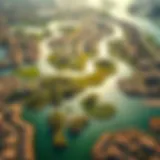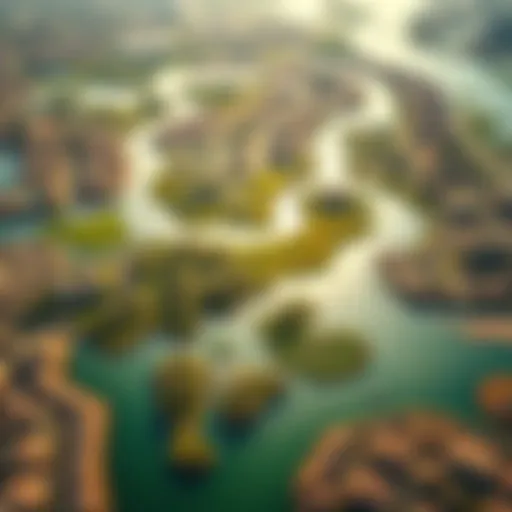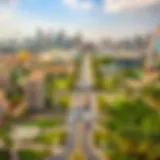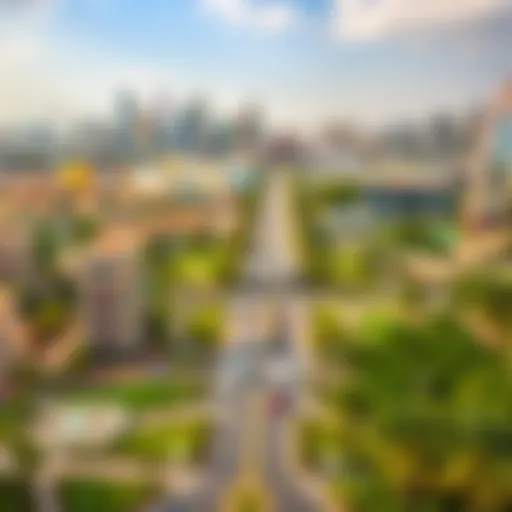Discovering the Unique Landscapes of Dubai
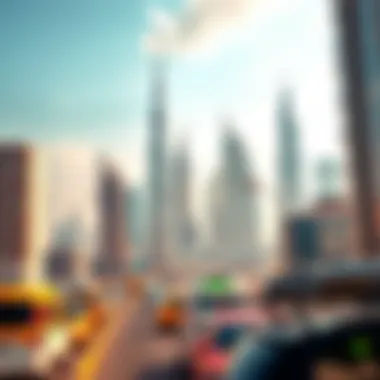
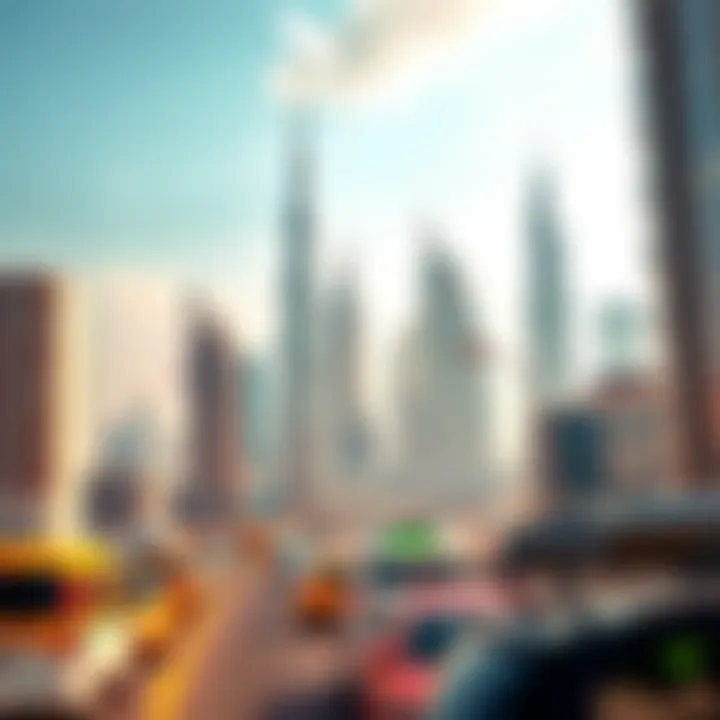
Intro
Dubai stands as a tribute to modern architectural innovation intertwined with the remnants of its rich cultural past. From the glimmering skyscrapers that punctuate the skyline to the tranquil expanses of the desert sands, the city's landscapes offer a tapestry of experiences that appeal to a diverse populace.
As we navigate through this guide, we will peel back the layers of Dubai's neighborhoods. Each one vibrates with its own rhythms, offering a unique blend of local charm, community engagement, and opportunities for exploration. Attention will be placed not only on the visual allure of these districts but also on their functional aspects—how they integrate design, lifestyle, and culture.
The primary focus will be to furnish homeowners, visitors, planners, and architects with insightful knowledge about the seamless connection between urban and natural elements in Dubai. With that in mind, let’s explore the foundational elements that shape this remarkable city.
Prolusion to Dubai's Unique Landscapes
Dubai’s landscape is not merely an assortment of stunning architectures and sandy beaches; it is a vivid tapestry woven from the threads of innovation, tradition, and natural beauty. The diversity found within the city’s varied environments is a testament to its growth and cultural richness. In this section, we delve into what makes Dubai's landscapes significant and how they reflect the ambitions and values of its people.
Understanding Dubai's Urban Fabric
At a glance, one might see a skyline punctuated by modern skyscrapers and vast shopping malls. However, beneath these glittering surfaces lies a complex urban fabric that merges functionality with aesthetic appeal. From Thorny bushes dotting the desert to lush green parks that interrupt the concrete jungle, Dubai embraces contrast. These urban environments are meticulously crafted to serve a growing population, yet they foster an atmosphere that welcomes collaboration between nature and structures.
An interesting fact is how the city uses geographical aspects to its advantage; for instance, the unique coastlines along the Arabian Gulf allow for stunning waterfront developments like The Palm Jumeirah. This deliberate interaction with nature has transformed Dubai into a vibrant destination that holds its own against other global cities.
The Role of Landscaping in Urban Living
Landscaping in Dubai is not just about creating pretty spaces; it plays a pivotal role in enriching urban life. Well-planned green areas provide residents with essential relief from the bustling city pace, promoting physical and mental well-being. Parks such as Al Safa Park and Zabeel Park serve as oases amidst the urban buzz, allowing families and individuals to unwind and connect with nature.
Also noteworthy is the impact of landscaping on community interactions. Public spaces often become gathering points for festivals, outdoor markets, and various family-friendly activities. This fosters a sense of community, where people from diverse backgrounds come together, enhancing cultural exchange and inclusion.
In sum, Dubai's unique landscapes feature an intricate blend of urban design and natural elements. They provide not only functional living spaces but also cultivate a societal framework that supports wellness and inclusivity. As we journey deeper into the neighborhoods of Dubai, we will see how these principles further manifest in the city’s evolution.
Key Neighborhoods and Their Characteristics
Dubai's neighborhoods tell a story of transformation, diversity, and community bonding. Understanding these key areas is crucial to appreciate the city’s evolution and find the right place that fits one’s lifestyle, be it for living, working, or exploring. Each neighborhood has its own unique character and offering, creating a mosaic that attracts both locals and tourists alike.
Downtown Dubai: The Heart of Urbanism
Architectural Innovations
The architectural innovations found in Downtown Dubai are not just structures; they represent a leap into the future. The Burj Khalifa, the world's tallest building, stands as a pinnacle of modern design, showcasing cutting-edge engineering and sustainability features. Its height, soaring over 828 meters, offers more than just bragging rights—it's a beacon that draws architecture enthusiasts and promotes tourism.
What makes architecture here particularly notable is the synergy between aesthetic appeal and functionality.
"Form follows function"—this principle is deeply embedded in the design ethos of Downtown. Buildings like the Dubai Opera not only captivate with their silhouette but also serve cultural purposes, hosting diverse events ranging from operas to pop concerts.
Advantages of such innovations include increased tourism as well as a robust economy, yet there are challenges, such as maintaining structural integrity in the face of harsh climate conditions.
Parks and Recreational Spaces
In stark contrast to the towering skyscrapers, the parks and recreational spaces in Downtown Dubai offer a breather from urban life. Spaces like Burj Park near the Burj Khalifa and Dubai Fountain provide residents and visitors with a lush green oasis, perfect for picnics or leisurely strolls.
The unique aspect of these recreational areas is their blend of calm alongside vibrant city life. The world-renowned Dubai Fountain, with its choreographed water shows, is a significant draw, attracting crowds daily. Still, the challenge lies in ensuring that these green spaces remain well-maintained in a bustling metropolis.
Community Events
Community events in Downtown Dubai foster a sense of unity and vibrancy. Festivals like the Dubai Shopping Festival and art events are vital for bringing residents together, promoting local culture, and stimulating commerce. These events act as a platform for local artists, entrepreneurs, and businesses, ensuring the neighborhood remains lively.
Noteworthy events include the annual New Year's Eve celebrations that grace the area with international firework displays and attract thousands. While these events bring excitement, they can also lead to crowd-control challenges and potential disruption to daily life.
Jumeirah: Coastal Charm and Elegance
Beachfront Landscapes
The beachfront landscapes of Jumeirah are not just for sunbathers; they are essential to the Emirates’ leisure culture. The pristine beaches, like Jumeirah Beach, are where visitors and locals find solace, making it a vital part of Dubai’s identity. With views of the iconic Burj Al Arab, these areas complement luxury living.
A key characteristic of this coastline is its blend of beach activities alongside cultural experiences, such as art installations and beachfront dining. Families and tourists enjoy a plethora of activities ranging from water sports to casual beach-side cafes. However, the downside is the increasing density of tourists during peak seasons, sometimes leading to overcrowding.
Cultural Attractions
Jumeirah is rich with cultural attractions, such as the Wild Wadi Water Park and the Umm Suqeim Park. These venues not only entertain but also educate visitors about Emirati heritage. Jumeirah's cultural wealth makes it a critical area in Dubai, as it showcases the blend of tradition and modernity.
The striking architecture of places like the Jumeirah Mosque offers enticing visuals and spiritual insights, allowing tourists to dive into Islamic culture. Challenges arise in navigating between preserving heritage and accommodating rapid development, demanding careful planning.
Sustainable Practices
Sustainability in Jumeirah’s developments is integral for keeping the coastline appealing and ecological. Efforts are underway to integrate sustainable practices like solar energy and efficient waste management systems in new constructions.
By promoting initiatives such as the planting of mangroves along the coast, Jumeirah aims to foster biodiversity while combatting the challenges posed by climate change. Such measures are beneficial for long-term environmental stability, albeit they require continuous monitoring and community involvement.
Dubai Marina: A Blend of Nature and Modernity
Waterfront Developments
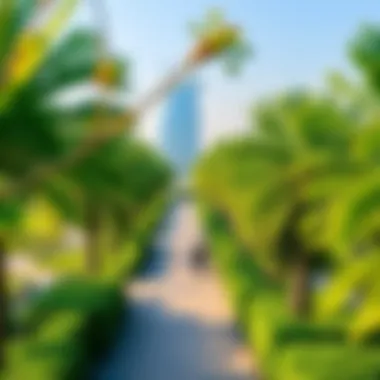
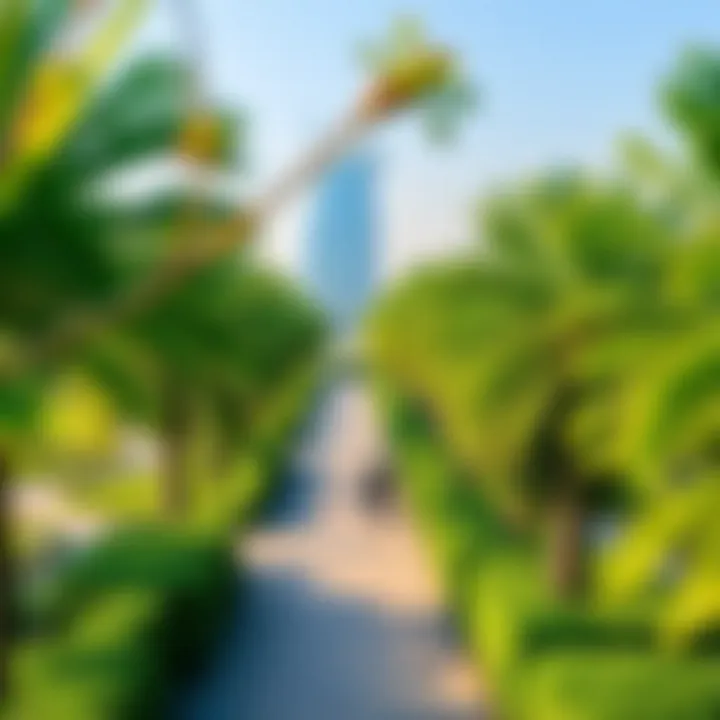
Dubai Marina's waterfront developments are a spectacle of modern architecture and urban planning, offering spectacular waterfront views that blend nature with urban life. With high-rise buildings enfolded around the marina, residents can enjoy a scenic, dynamic lifestyle rivalling any international city.
The key aspect here is the waterfront promenade, packed with cafes, shops, and leisure spots. These attract those looking for vibrant living options. Nevertheless, inundation fears arising during heavy rainfalls highlight the geographic vulnerabilities inherent to the area.
Community Life
Community life in Dubai Marina showcases a blend of cosmopolitanism and proximity to nature. The vibrant atmosphere is fueled by residents' enthusiasm for socializing, engaging in various community-driven activities ranging from yoga on the beach to weekend markets.
Local initiatives like neighborhood clean-ups and gathering events foster a sense of belonging among residents. The upside of this spirited life provides a welcoming environment, but there are challenges in ensuring all voices within the community are heard.
Green Initiatives
Green initiatives in Dubai Marina underscore the merging of luxury with eco-friendly practices. The incorporation of parks like the Marina Walk illustrates an effort to maintain green spaces amid high-density living. Programs focusing on recycling and energy conservation are gaining traction.
The prominent aspect of such initiatives is their contribution toward making urban living sustainable. However, implementing these programs might come at a cost, necessitating investment and community participation.
Al Barsha: A Residential Haven
Community Amenities
Al Barsha is known for its residential amenities that make living here a comfortable choice. With numerous shopping malls, schools, and healthcare facilities, it successfully caters to families and young professionals alike. The key characteristic of these amenities is their convenience combined with quality.
Al Barsha Mall stands out as a shopping hub that integrates entertainment, shopping, and dining. The challenge, however, lies in ensuring that this diverse offering does not lead to overcrowding or insufficient resources as population density increases.
Accessibility to Parks
Accessibility to parks in Al Barsha contributes significantly to the quality of life. Spaces like Al Barsha Park serve as green lungs for the community, providing areas for recreational activities and social interaction. The parks are designed with expansive walking paths, playgrounds, and fitness zones, promoting active lifestyles.
Such accessibility is beneficial, helping foster community spirit, but challenges remain in ensuring they are kept safe and clean for families and children.
Local Business Features
Local businesses in Al Barsha enhance the neighborhood’s charm, showcasing a diverse range of cafes, boutiques, and services. These establishments have evolved with the community’s needs, ensuring amenities are both localized and accessible.
A unique feature of these businesses is their dedication to providing personalized service, which builds connections within the community. Nonetheless, the competition with larger retail stores presents ongoing challenges, pushing small businesses to remain innovative and responsive to consumer demands.
Landscaping Trends in Dubai
Dubai stands as a prime example of how urban landscapes can evolve seamlessly with natural elements. Recognizing the importance of landscaping trends in this sprawling metropolis is key for anyone interested in the city's developmental narrative. Not only do these trends offer aesthetic appeal, but they also reflect the community's commitment to sustainability and innovation. This section delves into various landscaping trends that are shaping Dubai's outdoor spaces, showcasing the balance between lush greenery and urban living.
Sustainability in Landscaping
Sustainability has become a buzzword in urban design, particularly within an arid region like Dubai. The commitment to integrating environmental consciousness into landscaping is more than a trend; it is an essential approach guiding future developments.
Native Plant Use
Using native plants has emerged as a cornerstone in Dubai's landscaping strategy. The benefit of native plants lies in their adaptability and resilience to local climate conditions. This characteristic simplifies maintenance and promotes biodiversity. Their deep root systems not only anchor the soil but also assist in conserving water—a precious resource in the region.
Native plants, such as the ghaf tree or the date palm, exemplify this practice. These plants thrive naturally in the harsh desert environment, requiring minimal irrigation compared to non-native species. However, there can be challenges, such as limited visual diversity or slower growth rates. Yet, engaging local flora highlights a sense of place, beneficial for identity.
Water Conservation Techniques
Water conservation stands out in discussions surrounding landscaping in Dubai due to the significant pressures on water resources. Employing methods like drip irrigation and smart controllers has gained recognition. These techniques optimize water use, delivering it directly to the plant’s roots, thus minimizing waste.
The allure of efficiency drives their popularity among homeowners and developers. However, it’s crucial to note that the initial investment can be higher than traditional irrigation systems. Despite this, the long-term savings and sustainability benefits generally outweigh these costs.
Green Roofs and Vertical Gardens
The adoption of green roofs and vertical gardens has seen a noteworthy increase, especially in densely populated neighborhoods. These installations not only provide insulation but also combat urban heat, thus enhancing energy efficiency. Adding greenery to otherwise stark landscapes also supports the aesthetic appeal, contributing to the overall urban environment.
The unique feature of vertical gardens is their ability to transform walls into vibrant life spaces, improving air quality by absorbing carbon dioxide and releasing oxygen. Implementing such systems can be costly and demand ongoing care. However, their advantages in terms of enhancing property values and beautifying the environment can be significant.
Innovative Hardscaping Solutions
Innovative hardscaping has taken center stage alongside the greening trends. The materials and design approaches being applied redefine outdoor spaces.
Materials and Design Approaches
Dubai's innovative hardscaping utilizes both traditional and modern materials, carefully selected for durability against the extreme climate. Stone, porcelain, and concrete create structures that withstand the test of time. A focus here is on creating surfaces that are visually appealing and functional, catering to both practicality and style.
Design approaches encourage the creation of multifunctional spaces, incorporating features such as shaded areas for socializing or walking paths embedded with integrated lighting. However, the key characteristic of these materials can often lead to higher costs, which could deter some homeowners. Their long-lasting nature, though, can make them a worthy investment.
Integration with Natural Elements
The trend of integrating hardscaping with natural elements supports the objective of creating harmonious outdoor environments. The blending of stones with local vegetation allows for a natural flow, enhancing aesthetic appeal while providing ecological benefits.
However, achieving this balance requires thoughtful planning to ensure that hard surfaces do not dominate these green spaces. An advantage is the improved functionality of areas such as parks or private gardens where both elements coexist. But, achieving this integration can present design challenges, possibly affecting the layout and maintenance routines.
Durability and Maintenance
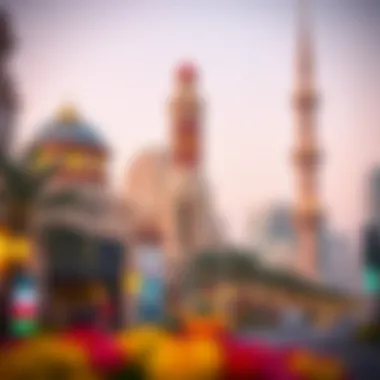
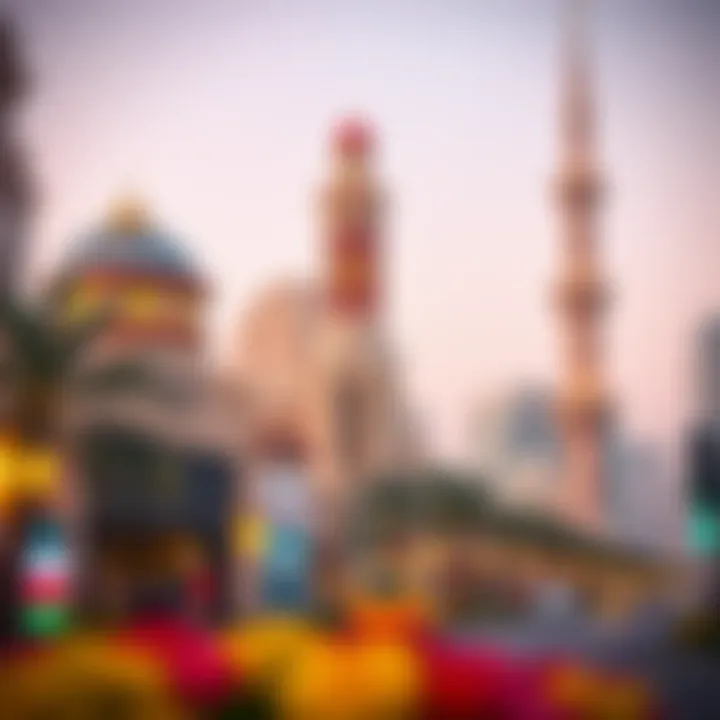
In a demanding environment like Dubai, the durability of landscaping components is non-negotiable. This focus leads to employing materials that can endure the high temperatures and sandstorms. Choosing options that require minimal upkeep is also attractive to homeowners seeking a balance between beauty and practicality.
Nonetheless, the unique feature of low-maintenance landscaping is not synonymous with zero maintenance; regular care is still required to protect these investments. Homeowners need to be cautious to prevent issues that could arise from neglecting upkeep.
In summary, as Dubai continues to grow, the landscaping trends highlighted here bring forth a blend of innovative solutions and sustainable practices. By adopting a comprehensive approach to landscaping, the city is set to maintain its unique identity while ensuring a brighter tomorrow for both its residents and the environment.
Lifestyle Features Across Neighborhoods
In a city like Dubai, the story is told not just through its towering skyscrapers but also through the lifestyle that each neighborhood offers. Understanding the lifestyle features across different neighborhoods adds depth to the overall experience of living or visiting Dubai. These features encapsulate the local culture, cuisine, shopping experiences, and entertainment options that paint a broad picture of what makes each distinct area tick.
Exploring this aspect enables us to appreciate the unique blend of tradition and modernity that defines Dubai. Residents, visitors, and professionals alike can find value in knowing where to dine, shop, and engage with the local culture.
Dining and Culinary Experiences
Local Cafés and Restaurants
Local cafés and restaurants in Dubai serve as the heartbeat of community life. These spots often reflect the city's rich blend of cultures through their diverse menus. Each café, with its unique interior design and ambiance, can offer a glimpse into the lifestyle of the locals. A key characteristic of these local establishments is their focus on community; they are not just places to grab a meal but often serve as social hubs where friendships are forged.
For instance, you might stumble upon a cozy nook in the Al Fahidi neighborhood, where local chefs serve traditional Emirati dishes alongside aromatic coffee. Such places provide not only a taste of the local cuisine but also invite visitors to experience the warmth of the community.
However, one downside could be that some cafés may lack the variety found in larger chains, but the charm lies in their authenticity.
International Cuisine Offerings
International cuisine offerings are a treasure trove waiting to be uncovered in Dubai. The city is a melting pot, and its eateries reflect the myriad cultures of its residents. This makes international cuisine not just a culinary experience but also a cultural journey.
From Japanese sushi to Italian pasta, the options can be as vast as your taste buds allow. A standout feature of these international restaurants is their attention to culinary authenticity; many chefs often import ingredients directly from their home countries to deliver genuine flavors.
This broad selection not only satisfies varied palates but also serves to bridge cultural gaps, allowing people to taste a slice of other cultures without leaving Dubai. On the flip side, the popularity of these establishments can lead to queuing issues, especially during peak hours.
Culinary Events and Festivals
Culinary events and festivals showcase Dubai's commitment to celebrating food in all its forms. They offer an opportunity for both locals and visitors to indulge their gastronomic passions while also fostering community spirit. A significant aspect of these events is how they frequently highlight local and seasonal ingredients, thereby promoting sustainability in the culinary sector.
Popular events like the Dubai Food Festival draw crowds with numerous food stalls, cooking demonstrations, and local chef showcases. They present a unique platform that not only entertains but also educates attendees about different cuisines. However, the downside may be overcrowding, making it sometimes a less enjoyable experience for those who prefer a quieter setting.
Shopping and Entertainment Venues
Shopping Malls and Markets
Shopping malls and markets in Dubai are more than just retail outlets; they embody the luxury and extravagance the city is known for. Malls like The Dubai Mall offer an incredible blend of shopping, entertainment, and dining in one location. This characteristic makes them a world-renowned shopping destination.
People from different walks of life gather here, be it for high-end fashion or experiential activities like skating rinks or aquariums. However, one could argue that the sheer size of these malls might lead to an overwhelming experience. For some, the charm lies more in local markets like the Souk Madinat Jumeirah, where the blend of tradition and modernity creates an authentic shopping experience.
Local Art and Culture
Local art and culture serve as the soul of Dubai's neighborhoods. Street art, galleries, and community exhibitions offer a glimpse into the artistic expression rooted in the local culture. A highlight is the Alserkal Avenue in the Al Quoz area, known for contemporary art spaces that showcase both local and international artists. This has put Dubai on the global art map, attracting art lovers and collectors alike.
Supporting local artists fosters a sense of community pride and encourages cultural dialogue. However, the ever-changing nature of the art scene means some might find it difficult to keep up with the new trends. Still, this vibrant cultural atmosphere adds to Dubai's dynamic appeal.
Family-Friendly Attractions
Family-friendly attractions in Dubai cater to all ages, making the city an ideal place for families to visit. Locations like Dubai Parks and Resorts provide multiple options for entertainment that ensures everyone has something to enjoy.
The emphasis on creating family memories makes these attractions not just about fun but also about bonding. Unique features such as themed zones and live shows help to create unforgettable experiences. However, it’s important to note that some attractions might become commercialized and lose the essence of local culture, potentially leaving visitors longing for deeper cultural engagement.
Overall, understanding the lifestyle features across neighborhoods is essential to experiencing the multifaceted personality of Dubai. Whether it's through dining, cultural experiences, or vibrant shopping locales, each aspect contributes to the city's unique allure that captivates both residents and visitors.
Architectural Landmarks and Cultural Significance
Architecture in Dubai isn’t just about erecting structures; it’s about creating a narrative that weaves together history, innovation, and culture. The iconic buildings tell tales of ambition and creativity, marking the landscape with their grandeur. As we take a closer look at the architectural landmarks in the city, it becomes evident that they serve not merely as visual spectacles but also as representations of the societal values and aspirations of the region. Every building contributes to a broader understanding of cultural significance, making it easier for residents and visitors to connect with this vibrant city.
Iconic Buildings and Structures
Burj Khalifa: A Testament to Innovation
The Burj Khalifa stands tall as a symbol of ingenuity. This towering structure isn’t just another skyscraper; it is the tallest building in the world, reaching a staggering height of 828 meters. It brings to mind not only Dubai's ambitions but also its capability to turn dreams into reality. One of the key characteristics of the Burj Khalifa is its unique design, which mimics the ancient desert flower, Hymenocallis.
Visitors often highlight its observation decks, where the views of the sprawling metropolis leave one speechless. However, it’s not without challenges. The sheer scale of the Burj Khalifa presents maintenance and environmental concerns, making it a double-edged sword of architectural achievement. Yet, its contributions to tourism and local economy are undeniably crucial as people flock to witness this architectural feat.
Dubai Frame: Linking Past and Present
The Dubai Frame offers a unique perspective that frames the old and new Dubai against each other. Opened in 2018, this structure is designed to mimic a huge picture frame, allowing visitors to catch a glimpse of the city’s heritage while simultaneously appreciating its modern skyline. The charm of the Dubai Frame lies not only in its design but its strategic location, positioned amidst the city's oldest and newest districts.
This innovative framework captures the essence of Dubai, reminding everyone of its rich history while looking into its future advancements. Its glass and gold-coated exterior stand out amid its surroundings, earning a favorable reputation among locals and tourists alike. However, concerns about its environmental impact and visitor congestion during peak hours have surfaced, raising questions on how such landmarks can remain sustainable in the long term.
Modern Art Installations
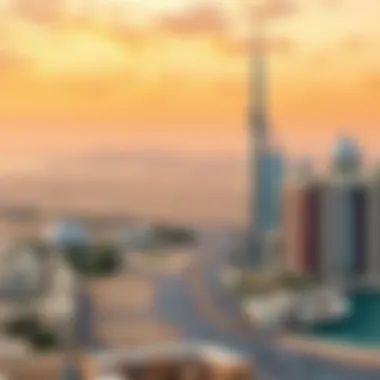
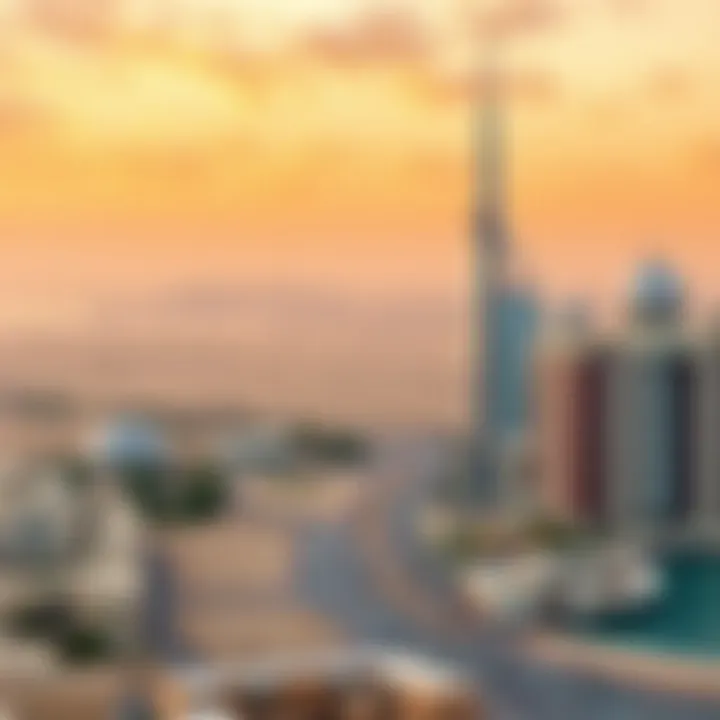
Modern art in Dubai is increasingly gaining recognition, showcased through several installations that breathe life into the urban environment. These installations often reflect the multicultural fabric of the city, resonating with both local and international audiences. They provide a platform for artists to express, challenge, and inspire discussion about contemporary issues.
Such installations are scattered around popular areas, including Dubai Design District and Alserkal Avenue, making art accessible to everyone. However, the challenge remains in ensuring these artworks are preserved amid rapid urban development. Often, they can be overlooked in favor of more commercial pursuits, leading to concerns over the value placed on artistic expression versus economic gain.
Cultural Heritage and Preservation
Understanding the past is integral to appreciating any culture, and Dubai has made significant strides in preserving its historical sites. The juxtaposition of cultural heritage against modernity raises a compelling narrative about what Dubai values most.
Historical Sites
Dubai's historical sites, such as Al Fahidi Historical Neighborhood, shine a light on the emirate's origins. They showcase traditional architecture, complete with wind towers and narrow lanes that tell stories of a simpler time. These sites are beneficial as they foster a sense of identity and continuity within a rapidly changing landscape. However, the preservation of these sites can be threatened by the constant pressure of urban expansion and modernization. Initiatives to protect these treasures exist, yet they must consistently evolve to keep pace with change.
Community Events Celebrating Traditions
Cultural events in Dubai serve as a lively canvas where traditions are showcased in full splendor. Annual festivals reflect the blend of cultures that coexist in the city. They celebrate everything from traditional Emirati dance to international art. These events offer the community a chance to engage and connect, reinforcing social bonds and shared values. However, while these events celebrate cultural pride, they also risk commercialization, which could lose the essence of their original intent.
Efforts in Cultural Education
Efforts to educate the community about its cultural heritage are vital for sustaining Dubai's identity. Various programs and workshops aim to share knowledge about historical practices, culinary traditions, and regional arts. These initiatives help bridge the gap between generations, fostering a continuous dialogue about what it means to be part of the Dubai community. Yet, finding the right balance between globalization and cultural preservation is an ongoing challenge, as educational endeavors can sometimes be overshadowed by the flashy, modern spectacles that dominate the skyline.
Community Engagement and Events
Community engagement plays a pivotal role in sustaining the dynamic fabric of Dubai’s diverse landscapes. It fosters a sense of belonging among residents while inviting visitors to partake in the local culture. Events and activities are the threads that weave the community together, allowing for shared experiences that transcend the hustle and bustle of urban living. When communities come together, they spark a transformation that enhances social cohesion, encourages participation in local governance, and promotes environmental stewardship. This section explores how annual festivals, local volunteer opportunities, and cultural events not only celebrate diversity but also empower individuals to make tangible contributions to their environment and society.
Annual Festivals and Celebrations
National and Cultural Holidays
National and cultural holidays in Dubai are more than just days off; they are vibrant displays of the UAE’s rich heritage. These holidays often involve colourful parades, traditional music, and delicious food festivals that showcase the multicultural essence of the city. Key events such as National Day on December 2nd and Eid celebrations are marked with fireworks and public gatherings, making them a popular choice for both locals and tourists. In particular, the family-friendly activities promote unity and increase awareness about the cultural fabric binding the Emirati people together.
One unique aspect of these holidays is how they foster intergenerational participation. Elders share stories and traditions with the younger generations, thereby preserving the culture while creating a sense of continuity. However, crowded venues can sometimes detract from the experience, making it a challenge for those with mobility issues. That said, the atmosphere of joy and unity often outweighs such concerns, making these celebrations a cherished part of the Dubai experience.
Art and Music Festivals
Dubai’s art and music festivals bring a kaleidoscope of creativity into the urban landscape, transforming public spaces into lively community stages. Events like the Dubai Jazz Festival, Art Dubai, and the Literature Festival not only entertain but also serve as platforms to showcase global talent. This aspect of cultural engagement allows local artists to gain visibility while also inviting international figures into the fold, thus promoting a rich dialogue about artistic expression.
These festivals are significant because they appeal to various demographics, drawing people in from all walks of life. Each expression of art serves as a conduit through which issues such as identity, community, and belonging are explored. A unique feature of these events is often the interactive installations that invite attendees to contribute, making them feel like part of the creative process. However, the venues can often become overcrowded, which might diminish the intimate experience some patrons seek.
Environmental Awareness Initiatives
Environmental awareness initiatives in Dubai often coincide with key community engagement activities. Programs like Earth Hour and community clean-up drives encourage residents to take an active role in preserving their environment. This aspect of engagement highlights the need for sustainable practices within urban living, driving home the message that individual contributions can lead to a larger impact.
One of the remarkable characteristics of these initiatives is their interdisciplinary approach—merging education with actionable strategies such as recycling, waste reduction, and water conservation. To some, these initiatives might seem small, but they resonate deeply with the community, fostering a collective sense of responsibility for the environment. On the flip side, inconsistent participation can limit the effectiveness of these activities, making outreach and awareness paramount for success.
Local Involvement and Volunteer Opportunities
Community Service Programs
Community service programs in Dubai represent a powerful force for societal change, inviting residents to contribute their time for the betterment of the community. Opportunities range from assisting in local shelters to participating in educational mentorship programs. These initiatives cultivate a passionate sense of purpose among volunteers, and many find that their own lives are enriched through giving back.
The core characteristic of these programs is inclusivity. They encourage participation from everyone, regardless of background or skills, and often emphasize teamwork and shared goals. However, the challenge remains in creating sustained engagement; individuals may volunteer for a short burst but struggle to maintain consistent involvement. Despite this, the temporary impact can lead to lasting change for community issues in the long run.
Neighborhood Improvement Projects
Neighborhood improvement projects focus on enhancing localized areas, whether through beautification campaigns or infrastructure upgrades. These initiatives often have tangible benefits seen in cleaner streets or restored parks, making the community more livable. Residents working together to enhance their immediate surroundings not only uplift the environment but also strengthen social bonds.
A key characteristic lies in the collaborative nature of these projects. They often include stakeholders from various sectors—local governments, NGOs, and the community—creating a platform for dialogue and cooperation. A potential downside, however, is the difficulty in securing funding and resources, which can stall promising initiatives. That said, when they do succeed, the impact resonates through the entire community.
Engagement with Local Governance
Engaging with local governance allows residents to actively participate in shaping the policies that impact their lives and surroundings. Public forums, town hall meetings, and feedback sessions empower individuals to voice their concerns while also being informed about community developments. This connection helps bridge the gap between civic authorities and citizens, fostering transparency and building trust.
One of the key characteristics of this engagement is its transformative potential. As citizens become more involved, they can influence decisions about urban planning and green spaces, which can ultimately improve their quality of life. However, some individuals may feel intimidated or unsure about sharing their opinions, particularly in larger forums. Finding a comfortable way to encourage participation is vital. Despite these challenges, active engagement leads to improvements that reflect the needs and aspirations of the community.
Finale: The Future of Dubai's Landscapes
The landscapes of Dubai are a reflection of ambitious vision intertwined with the essence of modern living. It's vital to recognize that the future of these variegated environments hinges on the sustainable coexistence of urban development and natural spaces. As residents and visitors admire the shimmering skyline, they must also appreciate the underlying ecological frameworks that support this dynamic city. The significance of this topic extends beyond mere aesthetic relevance; it encompasses long-term viability, environmental stewardship, and a commitment to cultural identity that resonate with all who engage with this vibrant locale.
Sustaining the Urban and Natural Balance
Sustaining a healthy balance between urban expansion and ecological conservation is crucial for Dubai's continued allure. Urban planners and architects are increasingly leaning on sustainable practices that incorporate green initiatives into the cityscape. This may manifest through:
- Integrating parks and green spaces: Creating a network of public parks allows residents to retreat from the hustle and bustle of city life and enjoy nature.
- Utilization of native vegetation: Planting species well-adapted to the local climate helps conserve water and reduces the need for chemical fertilizers.
- Green infrastructure: Implementing techniques like permeable pavements and bioswales can mitigate water runoff and promote biodiversity.
By prioritizing these elements, Dubai can not only enhance the quality of life for its residents but also establish a model for urban development that thrives alongside nature.
"A city’s future is not only mapped out through its buildings but also through its greenspaces—a symbiotic relationship that ensures livability and sustainability."
Vision for Continued Growth and Development
As Dubai looks ahead, the trajectory of its development is marked by innovative thinking and a reliance on technology. The vision includes:
- Smart city initiatives: Implementing IoT and smart grid technologies can improve energy efficiency and create a more connected urban environment.
- Sustainable transportation options: By promoting public transit, cycling, and pedestrian pathways, the city can reduce congestion and pollution.
- Community engagement: Involving residents in decisions about landscaping and urban planning fosters a sense of ownership and responsibility toward their environment.
The collaborative approach encourages adaptability and resilience, preparing Dubai to face future challenges while celebrating its unique identity. As thoughtful strategies take root, the city's landscapes will continue to evolve, ensuring that Dubai remains a beacon of progress anchored in responsible stewardship.








